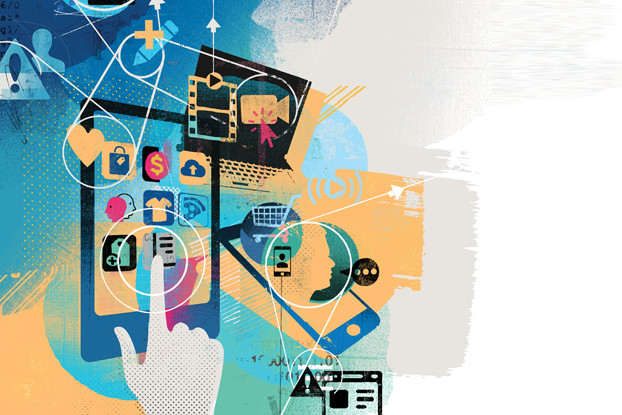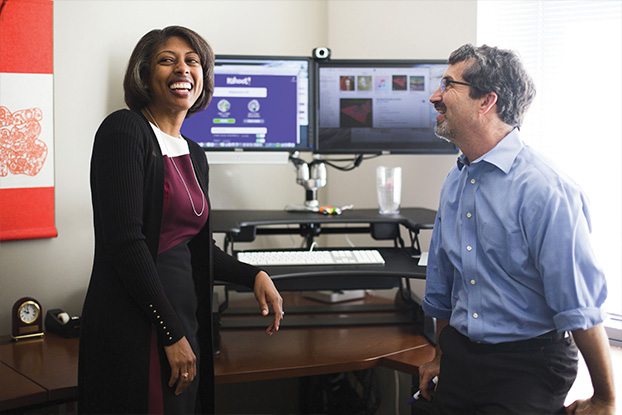It’s 6:15 a.m. The streets are still quiet when Madeline Parker* awakens to the chirp-chirp-chirp of electronic crickets on her smartphone’s alarm clock. Before turning on the bedroom lights, she opens her email, accepts a colleague’s lunch invitation, and reads a message from her favorite retailer about new winter styles on sale.
By the time she says good morning to her husband, Parker has already placed an order with a credit card and information she has on file, RSVPd to attend a business event, and added it to her calendar. After scanning the news headlines and her Instagram feed, opening a weather app to view the forecast, and making a quick bank transfer, she’s almost ready to get out of bed.
In minutes, Parker has packed in more daily tasks than previous generations may have done in weeks. She’s also transferred personal information to innumerable websites, a daily routine that could expose her to internet thieves. Are her actions misguided, or are the conveniences provided by technology too beneficial to pass up?
*Composite character
Race to adoption
Technology has become an integral part of everyday life. From morning exercise monitored by Fitbits to a ride to work courtesy of Uber, staying plugged in has become second nature for billions of global users.
Recent research indicates nearly 3.5 billion people now use the Internet, up from 394 million just ten years ago. This rapid surge in use began in 1995, when businesses bet on the Internet and the first tech IPOs brought new products and services to an audience growing in awareness and willingness to engage.
What followed was an “explosion of adoption and consumer-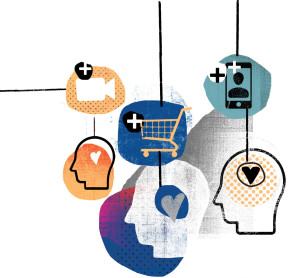 driven content,” says Benn Konsynski, George S. Craft Distinguished University Professor of Information Systems & Operations Management at Goizueta. “Consumers came online and were not just shopping but also adding content.”
driven content,” says Benn Konsynski, George S. Craft Distinguished University Professor of Information Systems & Operations Management at Goizueta. “Consumers came online and were not just shopping but also adding content.”
The shakeout from the 2000 Internet bubble left strong players like Microsoft and Amazon poised for expansion. Equally important, these surviving companies identified the elements needed to remain viable in a new business environment.
“What we learned from the market is that high valuations are in the context players, not content players. Netscape didn’t own much information, Google doesn’t create information. Craigslist, Amazon, and eBay don’t create much content,” explains Konsynski. “Instead, all of these players are creating high value by letting others create information. It’s what we call democratic production. Those that are able to exploit that high velocity, high volume of content creation are the ones that win.”
The evolution of smartphone applications has made it even faster and more convenient to conduct business, research, and shop online. Indeed, online sales, increasing through mobile apps, are making up a large chunk of the retail figures. According to Shop.org’s State of Retailing Online study, store-based retailers saw a 135 percent growth in sales on smartphones and an 86 percent boost in sales via tablets year to year.
“People want a seamless experience. Many of the in-store expectations are the same online: People want the right assortment, on-shelf availability, and good value,” says Jessica Cheng 07BBA, shopper insights manager at Procter & Gamble. “Shoppers used to associate online shopping with better prices, but that’s not necessarily the case now. People value other things more, such as convenience, free shipping, and exclusive offerings.”
Done correctly, a business’s online offerings should “supplement brick-and-mortar shopping. Programs such as subscription and customizable bundles give shoppers more control and freedom to shop for what they want, when they want it,” Cheng says. “We expect that such programs will make shopping more enjoyable for consumers and build greater brand and retailer loyalties.”
Consumers also thrive on the ability to build their online credibility by offering opinions, whether it’s blogging on a topic or critiquing a product on Amazon. The power to influence fellow users makes the strength of social media beneficial for commerce. And for many users, the personal recognition is equally valuable.
Take the current explosion of restaurant and fan reviews. Rhett Marlow 02WEMBA is tapping into this obsession with e-commerce brand and app foomanchew.com, a company that offers delivery of high-quality Asian cuisine, which they have established through extensive health-grade research. Marlow, who cofounded foomanchew and another technology-based company, believes coupling a trend with the assurance of a high-quality product is a recipe for success. It serves our appetite for convenience in two ways: reliable information and food delivery.
“For the customer using our app, the research is already complete,” Marlow says. “They are guaranteed a quality Asian food experience.”
Specialty apps like these are on the rise, and convenience tops the list of reasons. Statista, an online statistics company, reports that as of July 2015 more than 1.6 million apps were available for Android users, while Apple’s App Store offered 1.5 million. These apps cover every imaginable pursuit, from tracking personal fitness to monitoring fashion trends and shopping. But internet usage doesn’t stop there. For many people, unwinding with technology is just as vital a pursuit as working.
The binge mentality
Alex Slinin 05MBA, director of internet product development and management at Cox Communications, notes: “More than ever, consumers rely on the Internet for their communication and entertainment needs. The average US household has more than six devices connected to the Internet that they use for social networking, streaming video or music, gaming, web surfing, emailing, uploading photos, video chatting, and more. As a result, we are seeing internet data usage continue to double every
two years.”
For some consumers, the convenience and freedom of being able to tap into games or media whenever they please can be addicting. Gamers have been known to play 10 or even 24 hours straight, often leading to exhaustion or worse. For media viewers, there is the freedom to watch one episode of a program or devour an entire series in one sitting.
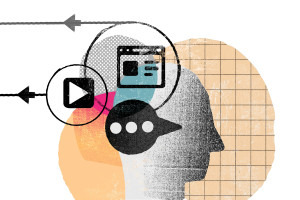 “The Internet has become a fundamental and constant thread throughout our lives, both in and out of the home,” Slinin observes. “For example, over the course of any given Saturday evening, about 90 percent of households have at least one device online.” Consumption, too, has changed, Slinin says. “During weekday evenings, video streaming of TV shows, movies, and other video clips comprises about 75 percent of all internet traffic.”
“The Internet has become a fundamental and constant thread throughout our lives, both in and out of the home,” Slinin observes. “For example, over the course of any given Saturday evening, about 90 percent of households have at least one device online.” Consumption, too, has changed, Slinin says. “During weekday evenings, video streaming of TV shows, movies, and other video clips comprises about 75 percent of all internet traffic.”
In new research, David Schweidel, Caldwell Research Fellow and associate professor of marketing, and coauthor Wendy Moe (University of Maryland), used data provided by Hulu, a streaming TV subscription service, to understand today’s protracted consumption of media—or binge—tendency. They found that “the more you watch a program, the more likely you will continue to keep watching that same program and to keep the viewing session going,” notes Schweidel.
This is not unlike what researchers describe as “flow,” a person’s ability to become so engaged in websites and online experiences that they lose track of time and what’s happening in the outside world. “With binge watching, a similar pattern to flow seems to occur. I am immersing myself in this experience,” Schweidel says. “Consider what Netflix did with its original series House of Cards, the political drama. They decided to offer the entire season at once. When Netflix announced the date that House of Cards would be available, people set aside that weekend to watch the entire series. Technology has enabled us to consume media whenever we want. I can say, ‘OK, I have Hulu, Netflix, and a DVR, and if I want to, I can watch one episode at a time, or I can decide to blow off the day and just watch TV.’”
There’s also a downside for businesses. According to Schweidel, this binge mentality is not great for a company’s bottom line. “From a business standpoint, the more you binge watch the less responsive you become to advertising,” he says. “This is not necessarily good for marketers.”
Clearly business benefits from consumers’ ability to engage with products, companies, and services at a moment’s notice and for as long as we desire. This flexibility has changed the way consumers schedule their time and resources. Email is checked incessantly, television is provided on demand, and smartphones are seen as an appendage that keeps us plugged in at all times. For some, this means overindulging in technology to the detriment of other, more valuable activities. Are the consequences of our internet addiction enough to curb the desire for more access and the subsequent privacy risks, or is the habit too appealing to stop?
It’s noon, and Parker is starving. But with meetings booked back to back and an overflowing inbox, leaving her building is out of the question. With smartphone in hand, she opens an app and places her lunch order for delivery. She walks downstairs to the coffee bar in the lobby and orders a latte, paying via another app that rewards her for frequent visits.
While she’s waiting for lunch back in her office, Parker scans her mortgage statement online, makes an additional principal payment, then logs out to instant message her husband about dinner plans. Lunch arrives, and she takes a seat while scanning the day’s top news and videos, all before returning to the chaos of her day.
Though some individuals are hesitant to virtually engage, for most people, technology has become a norm. “Habit-forming technology is already here, and it is being used to mold our lives,” says Nir Eyal 01C, author of Hooked: How to Build Habit-Forming Products. “A habit is at work when users feel a tad bored and instantly open Twitter. They feel a pang of loneliness, and before rational thought occurs, they are scrolling through their Facebook feeds. A question comes to mind, and before searching their brains, they query Google.”
Eyal describes this consumer truth as “the urge you likely feel throughout your day but hardly notice.” He contends that in engineering these habits, “companies increasingly find their economic value is a function of the strength of the habits they create.”
In his extensive research on how individuals use technology, Eyal recognizes that “habits keep users loyal.” Behavior, he acknowledges, can be shaped through promise of variable rewards. “The fact that we have greater access to the Web through our various connected devices—smartphones and tablets, televisions, game consoles, and wearable technology—gives companies far greater ability to affect our behavior,” he says.
Konsynski agrees: “We are moving to the algorithmic enterprise, with decisions driven by adopted algorithms more so than scripted decisions or human intervention. For better or worse, we are surrendering decision rights to systems that we trust to engage with volumes and velocities that humans can only poorly address.”
Willing to pay the price
Even if companies are profiting from our internet habits, the ability to get what we want, when we want it may prove an elixir so strong that we are willing to accept the consequences.
“Whether we’re sharing information consciously or not, we are making that decision,” says Schweidel, who wrote Profiting from the Data Economy. “It’s a trade: Facebook gives us a social network, a way to stay in touch with people, and we derive some value from that. What am I willing to give up in value? I’m willing to give up a lot of information about me.”
For companies like Twitter, Facebook, and Google that are built on advertising platforms, user information is culled and shared with advertisers as a means to pay the b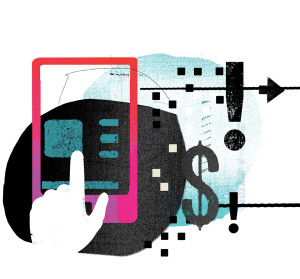 ills. From the contents of the “free” Gmail account, the ethnicity of the photos uploaded to Facebook, or the items searched, products can be tailored to an individual, thereby making personal data an attractive cache to advertisers.
ills. From the contents of the “free” Gmail account, the ethnicity of the photos uploaded to Facebook, or the items searched, products can be tailored to an individual, thereby making personal data an attractive cache to advertisers.
“Consumers care about access and convenience. Yes, there is an end user license agreement that goes along with apps—or the terms of service—and we are agreeing to these things. Now, whether or not we’ve actually read these documentations? That’s another story,” says Schweidel. “Technically, if you are using platforms like Twitter, Google, or Facebook, you have agreed to the terms of service, and in those agreements, you are granting your permission. There have been criticisms that those terms of service are so dense and long that no one ever reads them. But from a legal standpoint, the company is clear: You have clicked, and you have agreed. But are people fully aware of what they are agreeing to? Probably not.”
A call for more transparency is under way, as media attention highlights questionable collection of data that goes beyond the intended usage, like the 2014 discovery of a popular flashlight app that was gathering more personal data than necessary. Last year, the Obama administration released two reports around internet privacy and data, urging organizations to be more upfront with what and how data is being used.
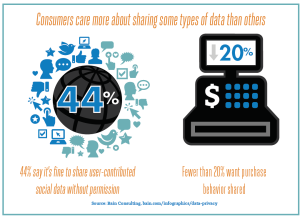
As long as there are opportunities to gather behavioral data, the collecting of information won’t stop any time soon. “The best companies are able to use this data in a positive way to delight their customers,” says Kelley Quinn Coram 15EvMBA, campaign manager for BrightWave, a leading email marketing agency. “We’ve all had an experience where we felt our data was misused. Think of that email list you somehow got on and can’t seem to unsubscribe from. It is a fine line that digital marketers deal with every day and is an ever-changing target. As marketers, we are trusted with our customer’s information and have to be good stewards of their data if we hope to keep them as a customer.”
Then there are digital ads that follow one’s activity around the Web. Called retargeting, the cookie or trail left by every search or visit to a website allows an advertiser to follow you and remind you of the item originally viewed. This is especially beneficial to retailers who, armed with the knowledge of what consumers are thinking of purchasing, can target reminders and coupons to convert that thinking into a sale.
Alok Deshpande 99BBA, president of SmartPath, a financial wellness company that helps reduce absenteeism, turnover, and financial stress for employees, explained retargeting to students as they strive to control spending. Using himself as an example, Deshpande told of researching the cost of a cruise for his family.
“Companies can figure out what you want to buy and then send online ads to you over and over,” Deshpande says. “Now there is nothing wrong with this, but you just need to be aware of this practice and really stay true to what you can afford.”
While computer users will notice this retargeting practice more readily, it may be less apparent on cell phones. “You may not notice retargeting as much on your mobile device because cookies have to be enabled on your device,” explains Michelle Andrews, assistant professor of marketing at Goizueta. “It may help consumers who are concerned about security to note that cookie data is anonymous and does not contain personally identifiable information. Because mobiles are considered more personal devices than desktops or tablets, though, it’s possible consumers will still be more concerned about mobile retargeting.”
Equally concerning, Andrews contends, is the common practice of using Facebook or Google log-in credentials to access other websites. “Sites that allow you to log in using Facebook often do so because they buy ad space on Facebook and want to deliver more targeted ads based on browsing information,” Andrews says. “Consumers have greater reason to be concerned about their privacy in this instance because logging into other sites via Facebook allows that site to request information about you from Facebook. Thus, the site can accumulate more information about you when you log in with Facebook than if you choose to log in with an entirely new or site-specific account.”
Convenience > risk
Clearly, with so many sites requiring passwords, using a shortcut like a Facebook log-in can make it easier to navigate the Web. But consumers are likely unaware of the rights to information they willingly click away when accessing content online. In other words, internet usage creates a push-pull effect of information, with companies wanting information about consumers and individuals wanting privacy along with online convenience. Add to this the hackers out to steal personal data stored by companies, and it’s enough to give one pause.
Or is it?
According to Ryan Hamilton, associate professor of marketing, consumers often underestimate the risks involved. Though each person will weigh risk and convenience differently, Hamilton says these judgments can be impacted by a mental shortcut called the “availability heuristic.”
“Consumers often estimate the likelihood of something by considering the ease with which they can bring instances of that thing to mind,” he says. “For example, when a person is trying to determine how likely they are to be seriously inconvenienced by fraud, they are likely to think of how many people they know who have had their lives seriously disrupted by fraud. Although most of us know people who have had some fraudulent charges on their credit cards, these are usually minor inconveniences. The person makes a phone call, and they are issued a new card. Cases where fraud has caused serious or lasting problems are much harder to bring to mind. So we estimate—accurately or not—that serious fraud is rare.”
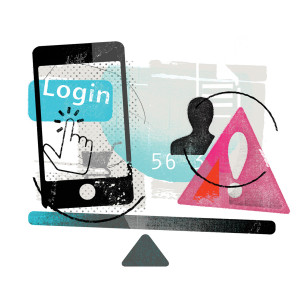 In other words, people tend to think that serious internet crime won’t happen to them. While consumers may dismiss such a threat, companies that collect personal data need to be vigilant.
In other words, people tend to think that serious internet crime won’t happen to them. While consumers may dismiss such a threat, companies that collect personal data need to be vigilant.
According to a report by the Ponemon Institute, which does independent research on privacy, data protection, and information security policy, 43 percent of companies surveyed in 2014 experienced a data breach. Well-publicized breaches last year included eBay, JPMorgan Chase & Co., and Neiman Marcus.
“If companies fail to follow basic industry practices of ensuring their data is secure—due diligence—then they face liability for data breaches,” says Allison Burdette, assistant professor in the practice of business law. “In fact, failure to exercise due diligence can mean that the company’s insurance policies will not cover the damages.”
This shift in liability from consumers to merchant allowed the rapid expansion of e-commerce, but it has increased the cost to companies.
“The threat of a data breach is a huge liability, and firms have started adding chief privacy officers and taking other measures to adequately protect their consumers’ data,” says Ramnath Chellappa, associate professor of information systems & operations management. “The alternative is to not store any consumer data, which obviously prevents companies from pursuing strategies that use the data. Another option for firms is to store modified forms of the data, which basically anonymizes the information to the merchant by storing larger profiles of customers as opposed to personal identifying information. For example, if you swipe your card at a counter at Target, why do they need to store your credit card number? That’s a onetime transaction so maybe don’t store it at all. Essentially, if you are storing consumer information, it’s your job to protect it. That’s the law.”
According to Gerry Baron 13WEMBA, economics often drive what companies do and don’t do regarding information security. Baron, chief marketing officer for Cirrity, a leading, channel-only secure cloud solutions provider, knows about helping businesses secure their data.
“Businesses are motivated to generate profits, and to the extent that they believe there are legal ramifications, industry regulations, or market drivers to invest in information security, they’re likely to take a minimalist approach,” he says. That can be particularly problematic, given that the cost per data breach is on the rise. Baron notes companies have to be ever vigilant when it comes to cyberhacking, and that means continuous monitoring to evaluate the business’s security posture in light of evolving threats and compliance requirements.
Cyberprotection is a two-way street
Even as many firms strive to prevent hackers from accessing data, consumers can be proactive by choosing awareness to circumvent the malaise that results from mindlessly checking email, sharing life updates on social media, or downloading the latest app. New challenges will arise as The Internet of Things (IoT), grows and more devices can connect or tap into the Internet. Thus, additional opportunities to monitor and capture consumer habits, locations, and activities emerge.
“Whether it is watches or refrigerators, pretty much anything that can have a chip attached to itself and an address assigned to it can communicate with other devices and send data,” Chellappa says. “The tech industry is rife with speculation that Apple is getting into the automotive business—after all, you can think about an automobile as a collection of computing and communication mechanisms on four wheels. The same goes with devices for the home, whether they ostensibly are meant to keep track of the temperature or used for security, they are collecting all types of information. You could have a completely digitized home that automatically knows when to shut off the lights. And these are not advances that will happen in the future. They already exist. They are not commonplace, but they will become commonplace because the cost and standardization of technologies will allow for anything to communicate with anything.”
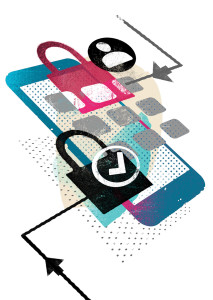 Data collection on consumers’ web activity will continue to reign as the driver of more products and services that bring convenience. However, it comes with a price. Since data can never truly be deleted, awareness will be the strongest deterrent to protecting personal information. Yet this has to go hand in hand with companies protecting the data they collect.
Data collection on consumers’ web activity will continue to reign as the driver of more products and services that bring convenience. However, it comes with a price. Since data can never truly be deleted, awareness will be the strongest deterrent to protecting personal information. Yet this has to go hand in hand with companies protecting the data they collect.
Baron admits it’s a struggle, especially with the new app economy. “It’s so easy to create a new app, and in a few minutes, there will be a ton of people using it,” he adds. Security is often an afterthought on the part of the app developer and the user.
Technology is continuously evolving, of course, and our thirst for and ease with technology means we are always going to be connected. “At the end of the day, it’s a delicate balancing act between convenience and security, whether it’s for the individual surfing the Web or for the company producing the consumer-facing technology,” says Jackie Breiter 01WEMBA, chief operations and information officer at Goizueta.
Consumers need to be especially aware of their online behavior and take an active part in protecting personal information whenever they can.
“Budgets determine the scope of data protection, and some companies will be better at it than others,” Breiter warns. “That puts the onus on consumers to determine their level of comfort when they choose to offer up information online.”
Parker has finished her office work for the day and returns home to make dinner from an online recipe. While she and her family eat, they catch up on a few episodes on Hulu. Later, after a Skype call to grandma and kids’ homework submitted via Google Classroom, she and her husband tuck their children in for the night.
With a fresh mug of tea at her side, she updates her Facebook page and uploads a gallery of the kids’ latest antics. Although she may include every point of information when she blogs about her latest DIY conquest, Parker doesn’t tag her children’s images. Without fully questioning why, Parker and her husband both understand some things are better left unshared on the Internet—just in case.
– By Michelle Valigursky and Nicole Golston


